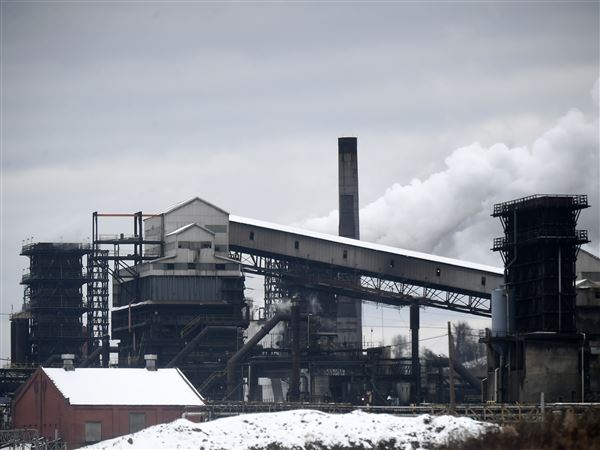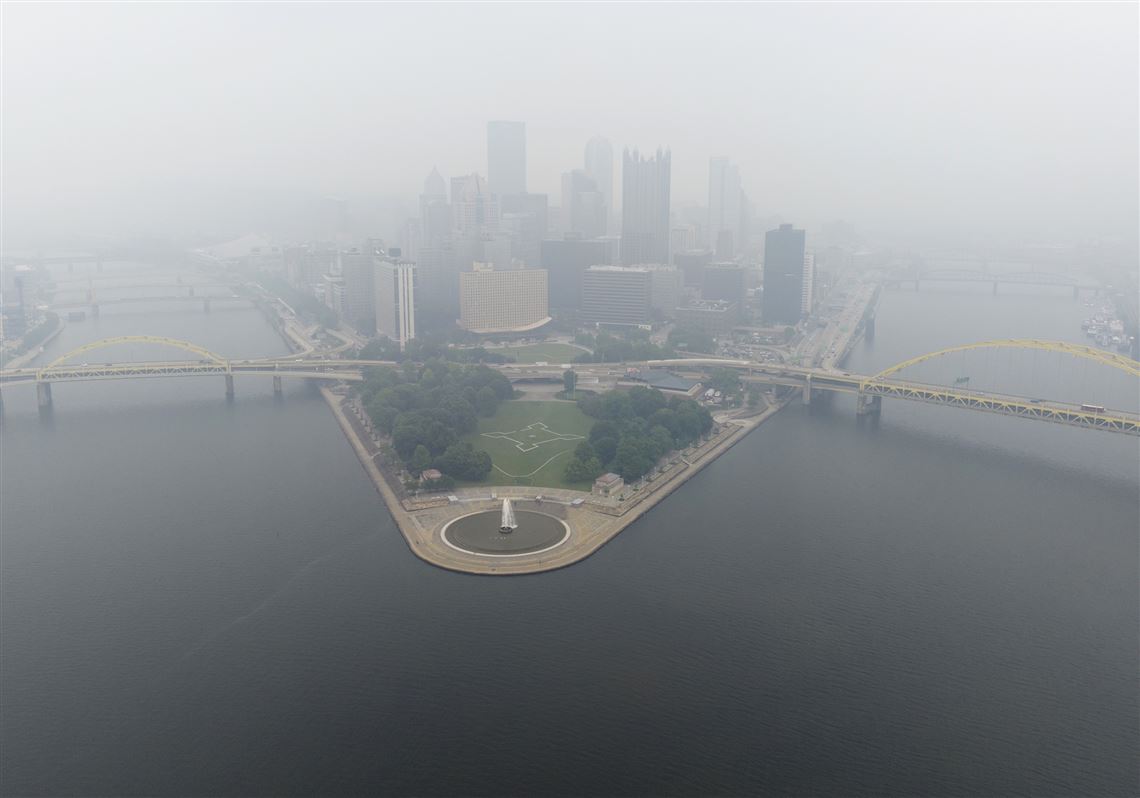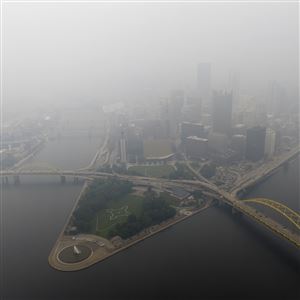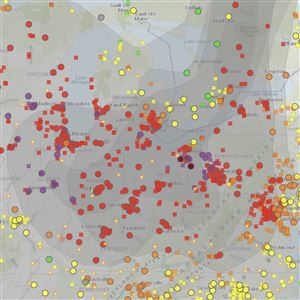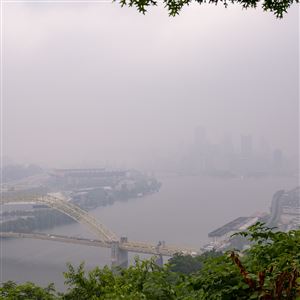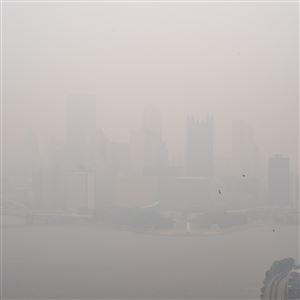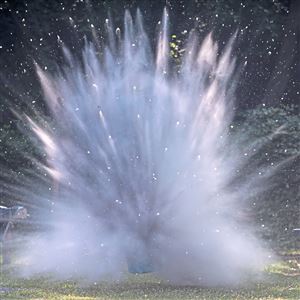Residents of Western Pennsylvania are seeing more smoke drift over from the Canadian wildfires, with the state Department of Environmental Protection declaring a code red air quality alert for Wednesday.
The DEP also announced Wednesday that a code red has been issued for Thursday for the entire state of Pennsylvania.
“On a Code Red Air Quality Action Day, young children, the elderly, and those with respiratory problems, such as asthma, emphysema, and bronchitis, are especially vulnerable to the effects of air pollution and should avoid outdoor activities, and everyone else should reduce prolonged or heavy exertion,” DEP wrote in the news release. “In Code Purple conditions, young children, the elderly, and those with respiratory problems should avoid all physical activity outdoors. Everyone else should avoid prolonged or heavy exertion.”
The release states that concentrations of smoke are expected to remain high throughout the day Thursday, and that wildfire smoke is expected to impact the region Thursday and Friday, with possible relief Saturday. Residents should check their local air quality for any regional changes.
“Conditions will likely be worse in the morning as a natural weather phenomenon called an atmospheric inversion will keep smoke filled air closer to the surface and prevent air from higher elevations to mix with air closer to the ground,” the release also said. Residents should avoid burning organic material, like leaves or trash, outside as well as avoid using gas-powered lawn equipment.
The DEP placed the eastern part of the state under a code red for Wednesday. The organization expected a code orange, but conditions worsened as smoke blanketed the region.
It’s a bit of déjà vu for area residents, as the region bounced along a color-coded scale earlier this month. Western Pennsylvania saw ratings as high as red, with increased health concerns from those with preexisting respiratory conditions and a warning to others to limit outdoor activity. An orange alert means the air is considered unhealthy for sensitive groups.
Of concern are the fine particulates — AKA PM-2.5 — contained in pollutants including wildfire smoke and which can include hundreds of chemicals.
Unhealthy air quality was detected in the Pittsburgh region as of 9 a.m. on Wednesday. Airnow.gov, with data from the Pennsylvania DEP and the Allegheny County Health Department, showed PM-2.5 levels in the “very unhealthy” purple range in some areas, including Pittsburgh earlier in the day, though by mid-afternoon that more serious level of particulates had dissipated. Still, in some areas, the air quality index hovered just below 200 PM-2.5, the border between red and purple.
The site states that people with heart or lung disease, seniors, children and teens should avoid physical activities outdoors, while everyone else should avoid strenuous outdoor activities and keep their time outside short. It also recommends rescheduling physical activities or moving them indoors.
Counties named for the Code Red Air Quality Action Day June 28 are: Allegheny, Westmoreland, Erie, Warren, McKean, Crawford, Mercer, Venango, Forest, Elk, Lawrence, Butler, Clarion, Armstrong, Jefferson, Clearfield, Indiana, Cambria, Beaver, Washington, Greene, Fayette and Somerset.
Some on social media were concerned about the “plastic-y” smell of the smoke. Michigan meteorologist Chris Easlick said in a tweet and conversation with a toxicologist that volatile organic compounds, emitted by wood fires, break down quickly in UV radiation, and that chemicals like benzene and formaldehyde can also be present and outlast other VOCs that smell like campfire.
Fires in Canada’s Quebec and Nova Scotia provinces began to spread rapidly in May and, by June 2, 3.3 million hectares — more than eight million acres — had burned, and 120,000 people had been displaced from their homes, Reuters reported earlier this month.
"Over the last 20 years, we have never seen such a large area burned so early in the season," Yan Boulanger, a researcher with Natural Resources Canada, told Reuters. "Partially because of climate change, we're seeing trends toward increasing burned area throughout Canada."
Wildfire smoke blanketed Allegheny County starting June 5, when PM-2.5 levels increased, according to a release at the time from the DEP. The DEP issued a code orange for the Liberty-Clairton area and Allegheny County that day, and Allegheny County issued a Mon Valley Air Pollution Watch June 6.
Code orange means that young children, seniors and others with compromising health conditions or respiratory problems should avoid outdoor physical activity.
By June 7, Western Pennsylvania was put under the more serious code red.
Conditions improved as the area received rainfall after a prolonged dry spell.
Throughout the early June episode, the Allegheny County Health Department posted on Facebook suggestions for how both companies and individual residents could help reduce PM2.5 levels.
“Companies most significantly contributing to particulate pollution in the Mon Valley region must continue to temporarily reduce particulate emissions” during alerts, per a June 5 post.
Residents, a post two days later stated, “can aid in the reduction of PM2.5 in the area by reducing or eliminating fireplace and wood stove use, avoiding the open burning of leaves, trash, and other materials, and avoiding the use of gas-powered lawn and garden equipment.”
Allegheny County Health Department tweeted on Tuesday about the alert, and directed people to its air quality database, which is updated hourly.
This is a developing story and will be updated.
Hanna Webster: hwebster@post-gazette.com
First Published: June 27, 2023, 8:40 p.m.
Updated: June 28, 2023, 9:50 p.m.






